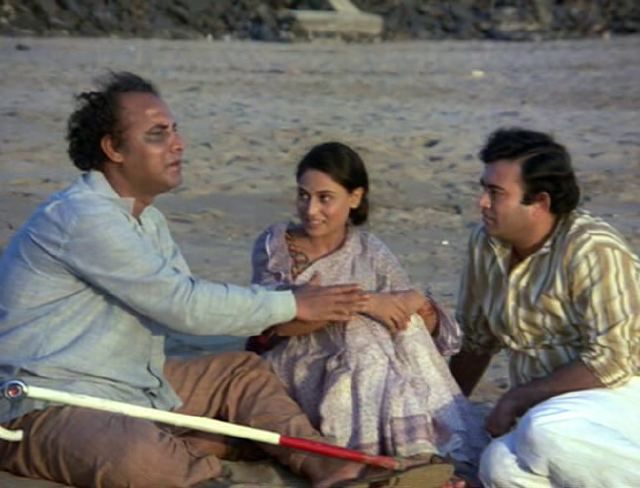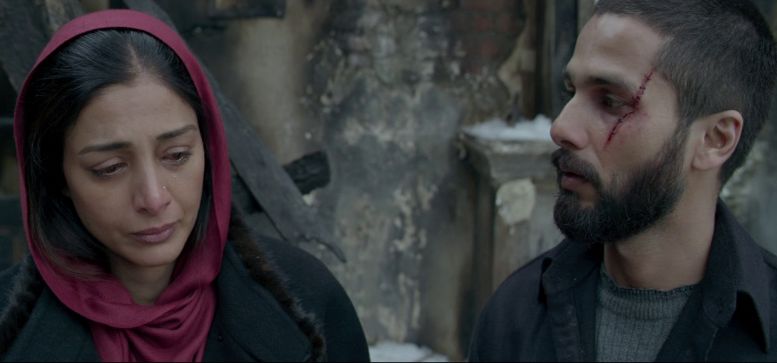Disability has been widely misunderstood by Indian society due to constant social marginalization and a lack of sensitization and awareness amongst the general public. While several entities have tried to bring about this awareness, their reach has been rather limited. Given this lack of awareness amongst the general public, media representation can provide a powerful medium for dissemination. Given the wide reach of the Bollywood industry, it can prove to be an effective tool for changing people’s perceptions and uprooting social stereotypes.[1]
The earlier portrayal of disability in Indian cinema followed a heteronormative path toward “fixing” disability, i.e., a disabled person meets an able-bodied person who helps them look past their disability to live a happy life. Examples of such are provided in the following paragraphs.
Disability has been seen as a punishment in Indian media for quite some time. One such portrayal was seen in the movie Jeevan Naya (1936),[2] where the lead character abandons his wife due to her background from a family full of dancers, which was considered shameful by the lead character, and subsequently is blinded in an accident and nursed back to health by a woman, who is revealed to be his devoted wife in the end. The movie Kashish (1980)[3] is another example, where the evil brother torments his deaf sister and brother-in-law and, later, becomes paralyzed, which he takes as punishment for his acts. In the movie Dhanwan (1981),[4] the rich protagonist is blinded and unable to buy a new pair of eyes, but later does find a benevolent donor only after he repents and turns to God. Similarly, in the movie Netrikaan (1981),[5] the lead character ends up in a wheelchair due to the lascivious life that he was living. This narrative not only shows disability as a punishment but also highlights the desexualisation of the disabled.
Apart from this narrative, more powerful representations have been shown where disability is portrayed as a punishment worse than death. In the movie Haider (2014),[6] the protagonist decides not to kill his uncle, who murdered his father, partly because his uncle had his legs amputated. In the movie Sholay (1975),[7] a policeman who had his arms amputated by a bandit duels against the bandit and does not kill him but crushes his arms instead.
Disability has also been used as a source of stigma and mockery. In the movie Guzaarish (2010),[8] the only wish of the paralyzed protagonist is to die. In the film Koi… Mil Gaya (2003),[9] an alien helps a child with learning and intellectual disabilities by restoring “normalcy” to his life and also helping the child to get a girlfriend. In such movies, disability is understood as a block that is necessary to be removed to have a normal life worth living. Such movies heighten the desires for normalcy of the general public, influencing the way disability is seen.
Movies such as Pyare Mohan (2006)[10] and Tom, Dick, and Harry (2006)[11] have protagonists with different disabilities but their interactions and limitations are used as a source of entertainment for the audience. In the movie series of Golmaal (2008),[12] one of the lead characters has a speech disability which has been exploited for comic relief.
Sultan (2016),[13] a sports drama movie that has won numerous awards, features a scene where the protagonist says: “Jab woh ladki ke aankh mein aankh daal ke dekhe na, toh andhi ladki bhi pat jawe” [When Shah Rukh looks straight into the eyes of a girl, even a blind girl cannot resist his charm].[14] This dialogue seems to be scripted into the movie only to generate a few laughs, as there is no other reason for this to appear in the movie.
Another recent movie offensive in mocking the disabled was Housefull 3 (2016).[15] In this movie there are three nondisabled men who pretend to be blind, deaf, and a wheelchair user, all just to marry three rich girls, whose father stipulated the condition to marry them off only to disabled men. This movie is full of insensitive dialogues such as: “Sab kuchh chal raha hai sirf main hi nahi chal raha hun” [Everything is moving except me].[16] When asked about the criticism faced by the movie, the directors unashamedly said: “If the janta [public] is happy, then that is the ultimate high.”[17]
Diverging from theses narratives, disability has also been equated to heroism. Films such as Dushman (1998)[18] and Aankhen (2002)[19] portray blind protagonists using their “sixth sense” to save the day. Such movies distort reality and do not help in improving or raising awareness of people living with disabilities.
The inability for people with disabilities to live independently has also been portrayed as a setback. Movies such as Dosti (1964)[20] and Khamoshi (1970)[21] depict people with disabilities as dependent upon other “abled persons.” While the movie Koshish (1972)[22] is seen as a landmark depiction of disability in Indian cinema by representing the life and struggles of a deaf person, it fails on account of a father begging for his deaf daughter to get married to his deaf employee’s son, which reinforces the idea of reliance of a deaf person upon a fully abled person for a successful life.
While there have been numerous negative portrayals of disability, there have been instances that have played an important role in generating awareness. Movies such as Barfi! (2012),[23] Taare Zameen Par (2007),[24] Main Aisa Hi Hoon (2005),[25] Sparsh (1980),[26] Black (2005),[27] and Margarita with a Straw (2014)[28] are movies that have had both box office and critical success and also helped change attitudes toward disability.
Sparsh is a 1980s movie that portrayed the potential and the challenges that hinder the success of blind people. Upon the release of this movie, the funding for the Blind Relief Association doubled, which is credited with kick-starting the discourse surrounding the disability movement in the 1980s.
Taare Zameen Paris a critically acclaimed movie that dealt with the issue of a child with dyslexia. It was such a huge success that, a few days after the release of the movie, the Central Board of Secondary Education issued a circular allowing students with disabilities extra compensatory time to complete their exams.[29] After the release of this movie, a lot of fashion shows started raising funds for disability organizations due to popular demand from customers.[30]
Main Aisa Hi Hoon is a film which revolved around a legal battle for child custody between a mentally challenged father and the maternal grandfather, who wanted to take his granddaughter back with him to the United Kingdom. This film not only dealt with the issue of using words such as “retard,” “paagal,” “handicapped,” etc., but also engagement with national as well as international laws and their applicability, demonstrating the sincerity and research put in by the team during the making of the movie. This movie also helped in shaping The Rights of Persons with Disabilities Act, 2016, India’s disability legislation passed by the Indian Parliament, which fulfills its obligation to the United Nations Convention on the Rights of Persons with Disabilities.
With movies still portraying disability in a negative, sometimes comical light, there is a need for even more sensitization and awareness, which is possible if movies stop resorting to stereotypes and provide opportunities for disabled actors to represent their community. To help the disability movement, Bollywood needs to make full use of its medium to spread the message and end the negative portrayal of disability in India.
Author Biography
Harsh Mahaseth is currently pursuing his Bachelor’s degree in law from the National Academy of Legal Studies and Research, Hyderabad, India.
[1]Wimal Dissanayake, “Rethinking Indian Popular Cinema: Towards Newer Frames of Understanding,” Rethinking Third Cinema, Routledge (2003); Priya Jaikumar, Cinema at the End of the Empire, Duke University Press (2006).
[2]“Jeevan Naya (1936),” http://www.imdb.com/title/tt0027817/.
[3]“Kashish (1980),” http://www.imdb.com/title/tt0279170/?ref_=fn_al_tt_1.
[4]“Dhanwan (1981),” http://www.imdb.com/title/tt0373790/?ref_=fn_al_tt_2.
[5]“Netri Kann (1981),” http://www.imdb.com/title/tt0279266/?ref_=nv_sr_1.
[6]“Haider (2014),” http://www.imdb.com/title/tt3390572/?ref_=nv_sr_1.
[7]“Sholay (1975),” http://www.imdb.com/title/tt0073707/?ref_=nv_sr_1.
[8]“Guzaarish (2010),” http://www.imdb.com/title/tt1438298/?ref_=nv_sr_1.
[9]“Koi… Mil Gaya (2003),” http://www.imdb.com/title/tt0254481/?ref_=nv_sr_1.
[10]“Pyare Mohan (2006),” http://www.imdb.com/title/tt0461323/?ref_=nv_sr_1.
[11]“Tom, Dick, and Harry (2006),” http://www.imdb.com/title/tt0476888/?ref_=nv_sr_2.
[12]“Golmaal (2008)” http://www.imdb.com/title/tt1405501/?ref_=nv_sr_5.
[13]“Sultan (2016),” http://www.imdb.com/title/tt4832640/?ref_=nv_sr_1.
[14]Author’s translation.
[15]“Housefull 3 (2016),” http://www.imdb.com/title/tt4559046/?ref_=nv_sr_2.
[16]Author’s translation.
[17] Charu Thakur, “Housefull 3: We Make Films for Public and Not Critics, Says Director Duo Sajid-Farhad,” India Today, June 2, 2016, https://www.indiatoday.in/movies/housefull-3-special/story/housefull-3-sajid-farhad-akshay-kumar-sajid-khan-riteish-deshmukh-abhishek-bachchan-11991-2016-06-02
[18]“Dushman (1998),” http://www.imdb.com/title/tt0189492/?ref_=nv_sr_1.
[19]“Aankhen (2002),” http://www.imdb.com/title/tt0306434/?ref_=nv_sr_2.
[20]“Dosti (1964),” http://www.imdb.com/title/tt0146645/?ref_=fn_al_tt_1.
[21]“Khamoshi (1970),” http://www.imdb.com/title/tt0142431/?ref_=nv_sr_5.
[22]“Koshish (1972),” http://www.imdb.com/title/tt0215911/?ref_=nv_sr_1.
[23]“Barfi! (2012),” http://www.imdb.com/title/tt2082197/?ref_=nv_sr_3.
[24]“Taare Zameen Par (2007),” http://www.imdb.com/title/tt0986264/?ref_=nv_sr_1.
[25]“Main Aisa Hi Hoon (2005),” http://www.imdb.com/title/tt0444874/?ref_=nv_sr_1.
[26]“Sparsh (1980),” http://www.imdb.com/title/tt0079938/?ref_=nv_sr_1.
[27]“Black (2005),” http://www.imdb.com/title/tt0375611/?ref_=fn_al_tt_2.
[28]“Margarita with a Straw (2014),” http://www.imdb.com/title/tt2929690/?ref_=nv_sr_1.
[29]Sayli Udas Mankikar. “Inspired by Taare…, Classes for Autistic Children,” Hindustan Times, April 13, 2008, https://www.hindustantimes.com/education/inspired-by-taare-classes-for-autistic-children/story-GCH5JRTmu6HGj5XBWyDiPN.html.
[30]K. Sawhnet, “Tracing the Portrayal of Disability in Indian Cinema,” Available at http://stanford.edu/~kartiks2/disabilityInBollywood.pdf.











































